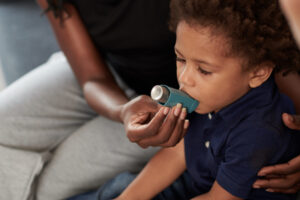Gas stoves are a significant health risk. This is true especially for children and the elderly. People who live in homes with gas stoves have more asthma, lung disease, and cardiovascular issues. We explain here the risks and offer steps that families who live in a home with a gas stove can take for better health. You will learn why some health professional societies and governments are urging a switch to electricity for cooking.
who live in homes with gas stoves have more asthma, lung disease, and cardiovascular issues. We explain here the risks and offer steps that families who live in a home with a gas stove can take for better health. You will learn why some health professional societies and governments are urging a switch to electricity for cooking.
“Gas stoves” refers to cooking using methane (also called “natural gas”) or propane. Burning these fossil fuels releases toxic fumes into the air of the kitchen: nitrogen dioxide, carbon monoxide, benzene, formaldehyde, and particulates. Most of these have no smell so that people are unaware of the danger. The concentrations of nitrogen dioxide in the kitchens of homes with gas stoves have been recorded to be triple the levels considered by the U.S. Environmental Protection Agency to be safe for outdoor air (EPA does not regulate indoor air quality).
Recent studies also show that even when the gas stove is shut off, the appliance is still leaking dangerous pollutants into your home. Of the more than 15 gas stoves sampled, 99% were leaking carcinogenic benzene at levels high enough to cause damage. Along with benzene, high levels of toluene, ethylbenzene, and xylene were also found – all of which are components of secondhand tobacco smoke.
Cooking fuels –from charcoal, wood, and biomass, to oil & gas– all produce hazardous air pollutants. Combustion of fossil fuels in particular (e.g. coal, oil, methane gas) releases carbon dioxide and other greenhouse gasses into the atmosphere, driving climate change and worsening the associated health problems of food insecurity, extreme weather, and forced displacement.

The biggest risk from gas stoves is childhood asthma. A review of 41 studies involving children concluded that those living in a home with a gas stove have a 42% increased chance of having asthma while living in the home, and a 21% increase of asthma later in their lives. The results are similar for younger or older children, and approximately the same for studies from North America, Europe, or Asia-Pacific. This is almost as bad as living with a tobacco smoker!
The American Medical Association, the American Academy of Family Physicians, and the American Academy of Pediatrics have each sounded the alarm. They urge health professionals to ask patients about home cooking practices and to ask communities to transition away from gas.
Advice for Families
The best health advice for families is to choose electric cooking when renting, buying, or building a home. It is interesting that professional chefs around the world are starting to prefer electric cooking, particularly using stoves with “induction” electric burners, because of electric’s superior cooking performance! Induction electric burners are also highly efficient and are likely to save families money because gas is so expensive.
Six Easy Tips You Can Share
Here are six easy tips for all families, and especially for those who rent or for whom replacing an entire kitchen appliance is not financially feasible.
First, open kitchen windows to bring in fresh air whenever possible. Remember that a gas stove releases toxins into your home even when the burners are turned off.
 Second, if there is an exhaust fan over the stove, always turn on the fan whenever you cook. This helps remove smelly odors and also the dangerous chemicals that have no odor such as nitrous oxide and carbon monoxide.
Second, if there is an exhaust fan over the stove, always turn on the fan whenever you cook. This helps remove smelly odors and also the dangerous chemicals that have no odor such as nitrous oxide and carbon monoxide.
Third, use the rear burners for cooking as your first choice because the exhaust fan is more effective at removing air pollution from the back burner.
Fourth, close doors leading from the kitchen to keep fumes out of other rooms. Americans spend more than 90% of their days indoors, so the quality of indoor air throughout the home is important.
Fifth, turn off burners as soon as they are not needed. Lastly, keep vulnerable people out of the kitchen while cooking is underway, particularly children under seven years old, anyone with asthma, and those with severe heart problems.
Better health is available when we switch to electric stoves, and even more so when our communities switch to generating electricity from renewable energy such as solar and wind power instead of burning fossil fuels. Ask your elected leaders to end any financial subsidies given to fossil fuel companies, to adopt building codes that discourage installing gas stoves and heaters, and to make a plan to abandon coal and gas for generating electricity. For homeowners, there is also federal funding in the Inflation Reduction Act that can provide both direct point-of-sale discounts and tax rebates for the purchase and installation of electric appliances such as electric induction stoves, electric water heaters, and electric furnaces. Choose your stove wisely with health in mind and cook safely every day!
building codes that discourage installing gas stoves and heaters, and to make a plan to abandon coal and gas for generating electricity. For homeowners, there is also federal funding in the Inflation Reduction Act that can provide both direct point-of-sale discounts and tax rebates for the purchase and installation of electric appliances such as electric induction stoves, electric water heaters, and electric furnaces. Choose your stove wisely with health in mind and cook safely every day!
My Green Doctor offers a new gas stove fact sheet for families. Choose your stove wisely with health in mind and cook safely every day!
Authors:
 Barbara Gottlieb ([email protected]) is Program Director for the Environment & Health Program at Physicians for Social Responsibility in Washington DC.
Barbara Gottlieb ([email protected]) is Program Director for the Environment & Health Program at Physicians for Social Responsibility in Washington DC.
 Zach Williams, MPH ([email protected]) is the Associate Director for the Environment & Health Program at Physicians for Social Respnsibility in Washington DC.
Zach Williams, MPH ([email protected]) is the Associate Director for the Environment & Health Program at Physicians for Social Respnsibility in Washington DC.
For more reading:
1. W Lin et al., “Meta-analysis of the effects of indoor nitrogen dioxide and gas cooking on asthma and wheeze in children.” Intl J Epidemiology 2013, 42: 1724-1737.
2. https://www.psr.org/blog/new-holiday-cooking-safety-guide-offers-tips-on-how-to-avoid-unhealthy-air-pollution-from-gas-stoves/ Accessed 8.7.2022
3. JM Logue et al., “Pollutant Exposures from Natural Gas Cooking Burners: A Simulation-Based Assessment for Southern California”, Environ Health Perspect 2014, 122:43–50.
4. https://pubs.acs.org/doi/10.1021/acs.est.2c02581


Pingback: ≫ Conozca los riesgos para la salud de las estufas de gas